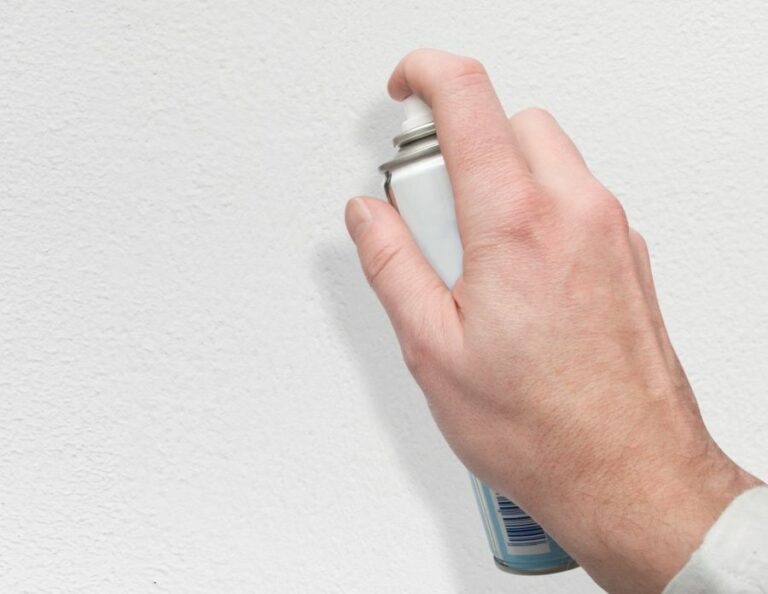Storing Spray Paint Cans Safely Post-Use. What Pros Say
Storing spray paint cans safely after use might feel daunting, especially if you’re unfamiliar with the proper technique. Worry not! We’ve got you covered with some easy-to-follow tips to ensure your paint cans are tucked away safely, prolonging their shelf life and preventing mishaps.
Storing spray paint cans safely post-use:
To safely store spray paint cans after use, ensure proper ventilation, temperature control (60-80F or 15-27C), and upright positioning. Keep cans away from heat sources, flames, children, and pets. Always seal the nozzle securely, dispose of empty or damaged cans properly, and periodically inspect stored cans for corrosion or leaks.

Curious about safely storing used spray paint cans? Good news, we’ve got you covered! Keep reading to learn simple, effective tips and techniques to ensure proper storage and prevent any mishaps.
Contents
- 1 Secure Storage of Spray Paint Cans After Use
- 1.1 • Proper Ventilation and Temperature Control
- 1.2 • Keep Away from Flames and Heat Sources
- 1.3 • Store in an Upright Position
- 1.4 • Properly Seal the Spray Paint Can
- 1.5 • Keep Out of Reach of Children and Pets
- 1.6 • Proper Disposal of Empty or Damaged Cans
- 1.7 • Regularly Inspect Stored Cans
- 1.8 • Label and Organize Your Spray Paint Cans
- 1.9 • Consider A Dedicated Storage Solution
- 2 Must Spray Paint Cans Be Stored Upright?
- 3 Storing Spray Paint in Your Garage: Is it Safe?
- 4 Ensuring Safe Storage of Aerosol Cans
- 4.1 • Understanding the Hazards of Aerosol Cans
- 4.2 • Tips for Safe Storage of Aerosol Cans
- 4.2.1 1. Store Aerosol Cans in a Cool, Dry Place
- 4.2.2 2. Keep Aerosol Cans Upright
- 4.2.3 3. Group Similar Aerosol Products Together
- 4.2.4 4. Store Away from Flammable Materials
- 4.2.5 5. Use Proper Storage Cabinets or Shelves
- 4.2.6 6. Ensure Proper Labeling of Aerosol Cans
- 4.2.7 7. Regularly Inspect Aerosol Cans for Damage
- 4.2.8 8. Dispose of Empty Aerosol Cans Properly
- 4.2.9 9. Train and Educate Users
- 4.3 • Conclusion
- 5 Is it Safe to Store Spray Paint Horizontally?
- 6 Flammable Cabinet Requirements for Aerosol Cans
- 7 Outdoor Storage of Spray Paint Cans: Is it Safe?
Secure Storage of Spray Paint Cans After Use
Spray paint cans are a common sight in many homes, workshops, and garages. They provide a quick and easy way to add color to various surfaces and objects. However, storing these cans properly after use is essential to ensure safety and prolong the life of the product.
• Proper Ventilation and Temperature Control
When storing spray paint cans, it’s crucial to choose an area with adequate ventilation, such as a garage or outdoor shed. This prevents the buildup of harmful fumes, which can be hazardous to your health. Additionally, proper temperature control is critical.
According to various manufacturers, spray paint cans should be stored between 60F and 80F (15C and 27C) to maintain their quality and prevent damage.
• Keep Away from Flames and Heat Sources
Spray paint cans are extremely flammable due to the chemicals they contain. As a result, they should always be kept away from direct sunlight, heat sources, and open flames. This includes avoiding storage near furnaces, water heaters, or other appliances that generate heat.
• Store in an Upright Position
To maintain optimum can pressure, it’s essential to store spray paint cans in an upright position. This ensures that the product remains properly mixed and ready for future use.
• Properly Seal the Spray Paint Can
Before storing your spray paint can, ensure that the nozzle is correctly positioned and secure. This helps to prevent accidental leaks and maintain the can’s internal pressure, promoting the longevity of the product.
In addition, I recommend cleaning the nozzle after each use to prevent clogging and ensure optimal performance.
• Keep Out of Reach of Children and Pets
To prevent accidents and ensure safety, store spray paint cans in an area that is secure and out of reach for children and pets. This might include placing them on a high shelf or locking them within a cabinet.
• Proper Disposal of Empty or Damaged Cans
If a spray paint can is empty or damaged, it’s crucial to dispose of it properly. Most municipalities have specific guidelines for disposing of hazardous waste, such as aerosols. Adhere to your local regulations or contact your waste management provider for further guidance.
• Regularly Inspect Stored Cans
Periodically inspect your stored spray paint cans to check for any signs of corrosion, leaks, or damage. If you identify any issues, it’s essential to address them immediately to prevent potential safety hazards.
• Label and Organize Your Spray Paint Cans
To easily locate specific colors, label each can with its color or finish type, and organize them accordingly. This not only saves time but also prevents any confusion that could lead to using the wrong paint in a project.
• Consider A Dedicated Storage Solution
If you frequently use spray paint or have a large number of cans to store, you might consider investing in a dedicated storage solution, such as a spray paint can rack or a cabinet. This not only ensures the safe storage of your cans but also provides an easily accessible and organized workspace.
In conclusion, proper storage of spray paint cans is critical to maintaining their effectiveness and ensuring safety, both for you and those in your household.
By following these essential steps and regularly inspecting your stored cans, you can continue to enjoy the convenience and versatility of spray paint without unnecessary risks.
Must Spray Paint Cans Be Stored Upright?
Spray paint cans are a practical and useful tool for various applications, from home improvement projects to artistic creations.
Proper storage is essential to ensure that the spray paint maintains its effectiveness, avoiding issues like clogged valves, improper paint mixing, or even dangerous accidents. One question that often arises is whether or not spray paint cans should be stored upright.
• The Importance of Proper Storage
Spray paint cans utilize a combination of solvents, pigments, and propellants that need to be maintained under the right conditions to ensure optimal performance.
The container’s design consists of an internal pressure system that relies on the proper distribution of contents and the maintenance of a specific pressure to allow for a smooth and consistent application of paint.
Proper storage will prolong the lifespan of the spray paint, preventing issues like deterioration or leaks that could compromise the quality of the paint.
Storing spray paint cans upright is the general recommendation due to several factors that contribute to its optimal performance, durability, and safety.
– Consistency and Mixing
Storing the cans upright allows the paint to settle at the bottom of the container regularly. Before using the spray paint, it is essential to shake the can to mix the pigments and solvents adequately, thus achieving a uniform application.
When the can is stored upright, the mixing ball readily moves and mixes the contents without getting stuck or lodged in an awkward position.
– Valve Functionality and Clogs
When a spray paint can is stored upright, it helps prevent the valve from clogging due to the solidification of the paint. When a can is stored on its side or upside down, the paint’s pigments can settle near the nozzle, making it challenging to dislodge them through shaking.
This can lead to poor paint flow, inconsistent spray patterns, and the potential for the valve to become permanently clogged.
– Safety and Leakage Prevention
Spray paint cans are pressurized, flammable containers, and improper storage can lead to dangerous situations. Storing the cans upright decreases the likelihood of leaks, either due to the valve or can losses due to corrosion or compromise.
This protects both the user and the environment, reducing the risk of exposure to toxic fumes, fires, or explosions.
– Temperature and Humidity Control
While not directly related to the orientation of the spray paint cans, proper temperature and humidity control are crucial factors in maintaining the integrity of the cans and their contents. Spray paint cans should be stored in a cool and dry area, away from sunlight and temperature changes.
The National Institute of Occupational Safety and Health (NIOSH) recommends storing them in a location with an ambient temperature between 60F and 80F and low humidity levels.
• Additional Tips for Proper Spray Paint Can Storage
In addition to storing spray paint cans upright, the following tips should be considered to ensure their optimal performance and extend their lifespan:
- Keep the cans clean: Wipe the nozzle and the can’s surface with a cloth or a paper towel after each use to prevent paint build-up or dust accumulation that could affect the spray paint’s functionality.
- Label the cans: Labeling the cans with the date of purchase and the color can help you track the age of the paint and make it easier to find the desired shade when needed.
- Inspect the cans regularly: Periodically check the cans for leaks, signs of corrosion, or damage. If any issues are observed, it’s recommended to dispose of the cans properly, following your local guidelines for hazardous waste disposal.
• Final Thoughts
In conclusion, proper storage of spray paint cans, including storing them upright, is essential for maintaining their effectiveness, safety, and longevity.
By following these recommendations and being mindful of other factors like temperature and humidity control, you can ensure that your spray paint cans are ready for use when needed, delivering consistent and satisfactory results in your projects.
Storing Spray Paint in Your Garage: Is it Safe?
The storage of spray paint cans in a garage is a question that receives mixed responses from experts and enthusiasts alike.
• Temperature Fluctuations
One of the leading concerns for storing spray paint cans in a garage is the potential for temperature fluctuations. Most manufacturers recommend storing spray paint cans between 60-80 degrees Fahrenheit (15-27 degrees Celsius) to maintain the quality and performance of the paint.
In many regions, garages are not climate-controlled or insulated, and as such, they may experience significant temperature variations that could negatively affect the shelf-life of your spray paint cans.
In extremely cold environments, the paint itself may freeze, resulting in a chunky or uneven consistency that cannot be used effectively. Similarly, in extremely hot temperatures, the can’s pressure may increase, making the spray paint potentially unstable and hazardous.
Recommendation: Measure the temperature range in your garage throughout the year to ensure that it remains within the safe temperatures for spray paint storage. If your garage is consistently too cold or too hot, you may consider storing the cans in a climate-controlled location.
• Ventilation and Air Quality
Proper ventilation is essential when storing spray paint cans in a garage. The chemical components within the paint can be harmful if they leak into the environment, potentially causing headaches, nausea, or respiratory issues for those using the space.
Furthermore, if garage spaces are frequently used for activities that may produce sparks or ignition sources (such as welding or grinding), the safe storage of flammable materials, including spray paint cans, must be carefully considered.
Recommendation: Ensure that your garage has adequate ventilation and consider using a dedicated storage cabinet designed for flammable materials to further minimize the risk of accidents or health issues.
• Protection from Damage and Accidents
In a garage, there is an increased likelihood of physical damage to spray paint cans, which could result in leakage or rupturing. Stored containers too close to the floor may be at risk of being damaged by water, corrosion, or forcefully knocked.
Recommendation: Store spray paint cans on a shelf or in a cabinet that keeps them elevated and away from potential hazards. Also, keep the containers organized and out of reach of children and pets.
• Compliance with Local Regulations
In some areas, there may be specific regulations governing the storage of spray paint cans in residential garages. These rules may include restrictions on the number of cans that can be stored or require specific storage solutions for flammable materials.
Recommendation: Consult your local fire department or building code office to determine if there are any requirements or restrictions for storing spray paint cans in your garage.
• In Conclusion
While it is not inherently problematic to store spray paint cans in a garage, there are critical factors to consider to ensure safety and effectiveness.
By taking into account temperature fluctuations, ventilation, protection from damage, accidents, and local regulations, you can create a safe and effective storage solution for your spray paint cans in the garage.
Remember, always handle spray paint cans carefully and responsibly, as they are both pressurized and flammable. If you decide to store them in your garage, be sure to implement the recommendations outlined in this article to prevent potential accidents or loss of product quality.
Ensuring Safe Storage of Aerosol Cans
The safe storage of aerosol cans is essential for maintaining a secure environment, whether at home or in the workplace.
• Understanding the Hazards of Aerosol Cans
Aerosol cans are pressurized containers that contain various substances, such as paint, insecticides, and cleaning products. When punctured, dropped, or exposed to high temperatures, these cans pose a risk of explosion, fire, or release of toxic materials.
Therefore, it is essential to handle and store them with care.
• Tips for Safe Storage of Aerosol Cans
1. Store Aerosol Cans in a Cool, Dry Place
As mentioned earlier, aerosol cans can explode when exposed to high temperatures. Therefore, the first step in safely storing these containers is to find a cool and dry location away from direct sunlight and heat sources.
Keeping the storage area well-ventilated is also crucial to avoid the accumulation of flammable vapors.
2. Keep Aerosol Cans Upright
It is essential to store aerosol cans vertically with the nozzle facing up to maintain the integrity of the internal pressure system. This position also helps prevent leaks, which can lead to exposure to hazardous chemicals.
3. Group Similar Aerosol Products Together
Organize your aerosol cans by type or use, such as grouping all paint products or cleaning products together. This practice helps to minimize confusion and the risk of accidentally grabbing the wrong canister during use.
4. Store Away from Flammable Materials
To minimize the risk of fire, aerosol cans should be stored away from combustible items such as paper, wood, and gasoline. This applies to both the aerosol cans’ storage location and the space immediately surrounding the cans.
5. Use Proper Storage Cabinets or Shelves
To minimize the risk of accidents, consider using specially designed storage cabinets or shelves to store your aerosol cans. These storage solutions typically have venting systems and are made of non-combustible materials, such as metal.
6. Ensure Proper Labeling of Aerosol Cans
Properly labeling aerosol cans with their contents and hazards is essential for safety. Be sure to include information on proper usage, precautions, and emergency procedures on each can.
This can prevent unintentional exposure to hazardous substances and educate users on how to handle emergencies correctly.
7. Regularly Inspect Aerosol Cans for Damage
Regularly check your aerosol cans for signs of damage, such as corrosion, leaks, or dents. Damaged containers should be removed from storage and handled according to the manufacturer’s recommendations or relevant safety regulations.
8. Dispose of Empty Aerosol Cans Properly
When an aerosol can is empty or no longer needed, make sure to dispose of it properly. This often involves taking the can to a recycling facility or hazardous waste collection site that accepts pressurized containers.
Never throw aerosol cans in the regular trash or puncture them, as this can pose explosion and fire risks.
9. Train and Educate Users
For workplaces or communal storage areas, providing training and education on how to handle aerosol cans safely can minimize accidents and improve compliance with storage guidelines.
Training should cover hazard identification, proper storage techniques, emergency procedures, and disposal methods.
• Conclusion
Storing aerosol cans safely is crucial for preventing accidents and minimizing hazards associated with these pressurized containers.
By following the tips outlined in this article, you can ensure a safer environment at home or in the workplace. Remember always to keep aerosol cans in a cool, dry place, store them away from flammable materials, and dispose of them properly when needed.
Step | Guideline |
|---|---|
1 | Store in a cool, dry place away from heat sources and direct sunlight. |
2 | Keep cans upright and do not stack them on top of each other. |
3 | Avoid exposing cans to extreme temperature fluctuations. |
4 | Store aerosols away from combustible materials, flammable liquids, and gases. |
5 | Follow any specific storage instructions provided by the manufacturer on the can’s label. |
6 | Dispose empty or damaged aerosol cans according to your local regulations. |
Is it Safe to Store Spray Paint Horizontally?
When it comes to storing spray paint cans, it’s essential to know the proper storage techniques to prolong the life of the paint and prevent potential hazards. Many people wonder if it’s okay to store spray paint cans lying down. The short answer is: no, it is not recommended.
• The Importance of Upright Storage for Spray Paint Cans
Spray paint cans contain both paint and a propellant, typically in the form of compressed gas. Unlike regular paint cans, they require the proper alignment of the internal components, such as the pickup tube and the nozzle, to function correctly. Storing the cans in an upright position ensures that:
- The paint and propellant are correctly layered: When the can is in its upright position, the paint settles at the bottom while the propellant stays on top. This separation allows the nozzle to release the ideal mix of paint and propellant when in use.
- The nozzle remains unclogged: If a spray paint can is stored lying down, the paint may clog the nozzle over time. When you eventually use the can, the clogged nozzle may cause sputtering and inconsistent spray patterns.
- The pressure is properly maintained: The propellant gas in the can is pressurized, and keeping the can upright ensures that the pressure is distributed evenly throughout the can.
• Potential Hazards of Storing Spray Paint Cans Lying Down
– Leakage
Storing spray paint cans horizontally increases the risk of leakage. Although spray paint cans are designed to be airtight, over time, the seal on the nozzle may weaken, allowing paint or propellant to escape.
This leakage might not only damage the surface the cans are stored on but also expose the area to flammable propellant fumes.
– Explosion Risk
Spray paint cans rely on highly pressurized propellants to function correctly, making them a potential explosion hazard if not stored properly. They should be kept away from heat sources, as exposure to high temperatures can cause the pressure to build up to dangerous levels.
Storing spray paint cans upright helps evenly distribute the pressure, reducing the risk of explosion.
• Best Practices for Storing Spray Paint Cans
– Optimal Environment
To prolong the life and maintain the quality of your spray paint cans, store them in a cool, dry place away from direct sunlight or heat sources. The ideal storage temperature for spray paint cans is between 60 and 80 degrees Fahrenheit (15 and 27 degrees Celsius).
– Using a Storage Rack
A storage rack specifically designed for spray paint cans can make it easier to keep them upright and organized. These racks vary in size and capacity, making them suitable for both small amounts of spray paint and a more extensive collection.
Storing spray paint cans on a properly designed rack will ensure not only that they’re kept upright but also that they’re accessible and easy to find.
– Rotating and Inspecting Your Spray Paint Cans
Regularly inspecting your spray paint cans is a good practice to maintain their quality and ensure your safety. When you check on them, make sure they’re free of any damage, such as dents, rust, or leaks.
Rotating the spray paint cans occasionally is also a good idea. Gently shake each can to mix the paint and propellant, ensuring that the nozzle is clean and functioning correctly before storing the cans upright again.
– Safe Disposal
When a spray paint can is empty or no longer usable, it’s essential to dispose of it safely. Most local waste management facilities have guidelines for the proper disposal of empty or damaged spray paint cans, so be sure to check with your local authority.
Never throw away spray paint cans in regular trash or try to recycle them without proper guidelines.
• Conclusion
In conclusion, storing spray paint cans lying down is not recommended due to potential issues with the car’s functionality and potential hazards.
Instead, follow the recommended best practices for proper storage, such as keeping the cans upright, using a storage rack, and maintaining an optimal environment.
By following these guidelines, you can enjoy a longer lifespan for your spray paint cans while also ensuring your safety.
For more information on spray paint can safety and storage, the Environmental Protection Agency (EPA) provides resources to help you better understand the hazards associated with these products and how to handle them properly.
| Can you store spray paint by laying it down? | |
|---|---|
| Recommended storage | Upright position |
| Issues with laying down | Possible leakage, mixing of paint and propellant, clogged nozzle |
| Storage temperature | Room temperature, away from direct sunlight and heat sources (50-80F) |
| Summary | It is not recommended to store spray paint cans by laying it down, as it can cause various issues. |
Flammable Cabinet Requirements for Aerosol Cans
Aerosol cans are common in various settings, from household products to industrial applications. Their convenience and ease of use make them popular options for various products, such as paints, lubricants, and deodorants.
However, it’s crucial to store these cans safely, given that they’re generally filled with flammable contents. The crucial question is, do aerosol cans need to be stored in a flammable cabinet?
• Understanding the Contents of Aerosol Cans
Before diving into the storage aspect, it’s essential to comprehend the contents of an aerosol can. Typically, these cans consist of three primary components:
- Product concentrate
- Propellant
- Container
The product concentrate is the primary substance the can is intended to dispense, whereas the propellant is the pressurized gas that pushes the concentrate out of the container. The container itself is usually a metal can, which is designed to withstand internal pressures.
The propellants used in aerosol cans are usually flammable hydrocarbons such as propane or butane, which are classified as Class 1B flammable liquids. As a result, storing aerosol cans safely becomes a priority, as their contents pose a flammable hazard.
• The Importance of Flammable Cabinets
Flammable cabinets are specifically designed to store flammable substances, ensuring that they are safe from ignition, heat sources, and unauthorized access. They also help protect the contents from any environmental, physical or chemical damage.
The National Fire Protection Association (NFPA) and the Occupational Safety and Health Administration (OSHA) both have stringent requirements regarding the design, construction, and performance of flammable cabinets.
In most cases, these cabinets must have self-closing doors, a 2-inch lip at the bottom to contain spills, and proper warning signage on the exterior.
• Understanding Regulations for Aerosol Cans Storage
Multiple regulatory bodies are responsible for requirements related to aerosol cans storage, primarily the NFPA and OSHA. Depending on the facility type and specific context, additional local or state-level regulations might apply.
According to NFPA 30, which provides guidelines for flammable and combustible liquid storage, aerosol cans must be stored in approved cabinets, unsealed containers, or storage rooms that meet necessary requirements.
Similarly, OSHA regulation 1910.106 outlines requirements for storage cabinets designed to hold Class 1B flammable liquids, which include aerosol cans. In most cases, these cabinets must be able to withstand a 10-minute fire test, ensuring that the contents remain protected during this timeframe.
• When Should You Store Aerosol Cans in a Flammable Cabinet?
In general, it is recommended to store aerosol cans in flammable cabinets, especially if they contain flammable propellants. However, specific circumstances might warrant alternative storage options.
For small-scale or household use, aerosol can storage in a regular cabinet may be sufficient, assuming that it is far from heat sources or ignition points. However, for facilities that store large quantities of aerosol cans, such as warehouses or workshops, it is crucial to use flammable storage cabinets.
Additionally, industries involving hazardous or regulated substances should always opt for flammable cabinets when storing aerosol cans, even in minimal quantities.
• Tips for Storing Aerosol Cans Safely
When considering storing aerosol cans, here are some expert recommendations:
- Use flammable storage cabinets designed to conform with NFPA and OSHA standards.
- Always keep an inventory of aerosol cans stored and maintain a proper labeling system for easy identification.
- Keep aerosol can storage areas well-ventilated to prevent the accumulation of flammable vapors.
- Regularly inspect aerosol cans for damage or leakage, and dispose of damaged or expired cans safely.
- Store aerosol cans away from ignition sources, including electrical equipment, machinery or heating systems.
- Train employees on the hazards associated with aerosol cans and appropriate safety measures when handling them.
• Conclusion
In response to the question, “Do aerosol cans need to be stored in a flammable cabinet?” the answer is that it is strongly recommended, particularly in industrial or commercial settings.
Due to the potentially hazardous nature of aerosol can contents, storing them in flammable cabinets will help protect against accidental ignition, physical damage, and unauthorized access. Always adhere to NFPA, OSHA, and local regulations to ensure the safety of your facility and employees.
Outdoor Storage of Spray Paint Cans: Is it Safe?
Spray paint cans are incredibly useful tools for various DIY and professional projects. However, many people are unsure whether they can store these cans outdoors and how exposure to varying temperatures and humidity levels may affect their performance.
• Importance of Proper Storage
Proper storage of spray paint cans is essential to ensure their longevity and maintain their performance. When exposed to harsh outdoor conditions, the cans may suffer from a range of problems, including compromised pressure, thickened paint, and eventual damage to the containers.
Understanding what factors influence the storage of spray paint cans will help you make informed decisions about storing them outdoors.
– Temperature Considerations
Spray paint cans are affected by temperature fluctuations. These fluctuations can cause changes in pressure within the cans, potentially leading to diminished performance or even explosions.
For optimal results, it is recommended to store spray paint cans in a temperature-controlled environment, ideally between 16°C to 27°C (60°F to 80°F).
Storing the cans outside in extreme heat or cold can cause issues such as:
- Freezing temperatures: At or below 0°C (32°F), the paint inside the can may freeze and render the spray paint can unusable. Frozen paint can become thick, and chunky, and may not properly adhere to surfaces.
- High temperatures: Exposing spray paint cans to temperatures over 49°C (120°F) can lead to increased pressure inside the can, potentially causing leakage, paint deterioration, or explosions.
– Humidity Concerns
Humidity levels in outdoor settings can also harm spray paint cans. High humidity can cause the metal components to rust or corrode, damaging the can’s integrity and causing leaks or pressure issues.
In extreme cases, moisture may even infiltrate the can, compromising paint adhesion and drying times.
Low humidity is less of a concern but can still affect the paint’s performance. Dry environments may cause the paint to thicken or solidify more quickly than intended, potentially leading to clogging or reduced spray coverage.
– Exposure to Sunlight
Direct sunlight can impact both the cans’ exterior and the paint within them. Ultraviolet (UV) rays may cause the cans’ labels to fade and become illegible, making it challenging to identify the cans’ content.
Additionally, prolonged exposure to sunlight can raise the cans’ internal temperature, exacerbating the issues associated with high temperatures mentioned above.
• Recommendations for Outdoor Storage
If storing spray paint cans outside is the only available option, consider the following recommendations to minimize potential issues:
- Temperature regulation: Choose an outdoor location that remains relatively cool and evenly temperatures, such as a shaded area or a well-insulated shed. Avoid areas that experience significant temperature fluctuations.
- Humidity control: In high-humidity environments, consider using silica gel packets, dehumidifiers, or moisture-absorbing materials to reduce the moisture levels around the cans. Store the cans off the ground, using shelves or racks, to minimize contact with damp surfaces.
- Sunlight protection: Store spray paint cans in a location where they will not be exposed to direct sunlight, like a covered storage area, or use containers or cabinets to shield them from UV rays.
- Regular maintenance: Regularly inspect spray paint cans for signs of rust, corrosion, or leakage. Rotate the cans periodically to avoid long-term contact between individual cans, which may cause them to stick together or corrode.
• Alternative Storage Solutions
In some cases, outdoor storage may not be the best option for maintaining the lifespan and performance of spray paint cans. Consider exploring alternate storage solutions, such as:
- Renting a climate-controlled storage unit or garage space.
- Asking friends or family members to store the cans in their homes or other indoor locations.
- Storing cans in a dedicated, temperature-controlled closet or cabinet in your home.
By following these recommendations and understanding the factors that can influence the storage of spray paint cans, you can effectively store your cans outside with minimal risk to their long-term performance.







